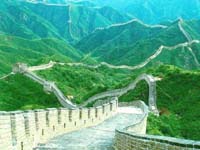Sandstorms wreck sections of Great Wall

Western sections of the Great Wall were destroyed to "mounds of dirt" by sandstorms and may even disappear in 20 years.
The reasons for the deterioration are entirely manmade, the official Xinhua News Agency said, pointing to destructive farming methods in the 1950s that desertified areas of northern China, causing sandstorms.
"Frequent storms not only eroded the mud, but also cracked the wall and caused it to collapse or break down," Xinhua quoted archaeologist Zhou Shengrui as saying.
One of the most threatened sections of the wall runs through Minqin county in Gansu province along the ancient Silk Road trade route. Unlike the better-known stone and brick sections around Beijing, the wall in Gansu is made of less-resilient packed earth that easily erodes.
"Similar erosion happened to the Great Wall in other places, but the situation is much worse here," Zhou was quoted as saying.
More than 40 kilometers (25 miles) of wall in Minqin have disappeared in the past 20 years, Xinhua said.
Lookout towers have vanished and the wall's height has been worn down from 5 meters (16 feet) to less than 2 meters (7 feet), it said.
Tourism, neglect and sometimes willful destruction by developers have also taken their toll on the wall, designed to defend against foreign invaders. The earliest sections date back more than 20 centuries and its total length has been estimated at 5,000 to 6,500 kilometers (3,000 to 4,000 miles).
Xinhua said Minqin conservationists hoped to protect the remaining sections in their county from wind and sandstorms by covering them with dirt. Eventually, they hope to replant enough vegetation to prevent future sandstorms, it said.
Subscribe to Pravda.Ru Telegram channel, Facebook, RSS!




